flame resistant
RUSSIAN NANO MATERIAL
Intumescent fire retardant coating with nanoparticles
◆ Lightweight
◆ Forms thin layer
◆ Easy to repair
◆ Excellent decorative properties
WHAT IS RUSSIAN NANO MATERIAL
Lately industrial and commercial frame building featuring supporting steel structures has been in great demand. Such construction methods have several advantages over brick masonry, monolithic construction and other kinds primarily due to reduced construction time, cost and weight of buildings built with such technologies.
However,using this construction technology requires a lot of attention to the protection of load- bearing parts from corrosion, condensation and fire exposure in the event of a fire. Along with corrosion-resistant rust primer NANO-FIX ANTICOR and insulating coating RUSSIAN NANO MATERIAL our company developed a highly efficient fire- retardant paint RUSSIAN NANO MATERIAL.
In the event of fire, bearing metal structures are subjected to high temperatures and begin to deform. This phenomenon leads to the destruction of an entire building over a very brief period of time.
In order to delay the moment of building collapse due to the heat produced by the fire, it is necessary to protect metal surfaces from heat exposure. RUSSIAN NANO MATERIAL intumescent fire-retardant properties allow it to expand under heat exposure up to 50 times. While expanding RUSSIAN NANO MATERIAL forms refractory foam that has low thermal conductivity, which prevents flames and heat from reaching metal surfaces. Thus, RUSSIAN NANO MATERIAL restrains flame temperature up to 90 minutes. This amount of time is assumed to be sufficient for a complete evacuation of personnel from the premises and for arrival of emergency response team to the site, assuming that they would have time to put out the fire before the building starts to collapse.
Fire-protective coating RUSSIAN NANO MATERIAL is produced with American and European-made components on high-tech equipment that allows components to be processed up to their optimum level of mixing and grinding. It should also be noted that RUSSIAN NANO MATERIAL fireproof composition includes nanostructured particles (nanoplatelets) of alumina which contributes to its durability, strength and resistance to humidity.
In addition to fire-retardant paint our company offers anti- corrosion primer NANO-FIX ANTICOR that protects metal from corrosion under a layer of fire-retardant paint. NANO-FIX ANTICOR would last for up to 30 years in outdoor conditions. Together, these coatings make up a system quality for which the manufacturer, Innovative Technologies takes full responsibility.
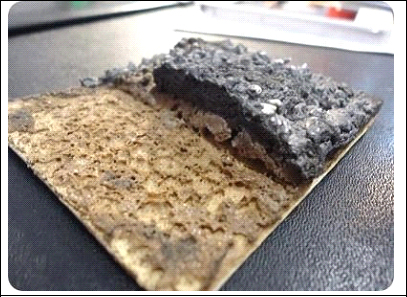
Foam layer formed due to direct fire treatment of RUSSIAN NANO MATERIAL coating 0.7mm thick.
RUSSIAN NANO MATERIAL APPLICATION OBJECTIVES
1. To rescue and protect personnel: - Safe evacuation of people from a building within a defined period of time; - Establishment of a certain area or secure space in a building for a specified period of time.
2. To protect property and assets:
- Fire protection of various units, sections of buildings and equipment;
- Preventing spreading of flames around an object;
- Protection (insulation) of objects from fire exposure.
RUSSIAN NANO MATERIAL PRINCIPLE OF OPERATION
When exposed to an open fire retardant intumescent coating RUSSIAN NANO MATERIAL expands and forms a flame-imbued ashy foam that protects the surface it was applied to in order to protect it against overheating and destruction.
On the picture below is RUSSIAN NANO MATERIAL (average coat thickness is 0.7 mm) applied on a sheet of corrugated board (the board is 2.5 mm thick)
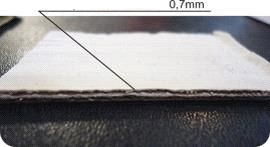
This is what the foam created due to a thermal influence of fire of a surface pained with RUSSIAN NANO MATERIAL looks like. The foam is usually about 35mm thick. The cardboard under a layer of RUSSIAN NANO MATERIAL sustained fire exposure and remained intact.
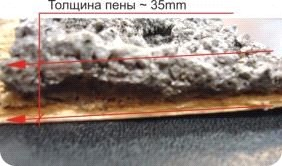
SCOPE OF APPLICATION
RUSSIAN NANO MATERIAL, being a highly-effective flame-retardant substance can be used in construction in the following sites and construction nodes:
1.Protecting and supporting structures made of concrete and reinforced concrete
Concrete and reinforced concrete are not subject to combustion, but heat treatment in general and an open flame in particular can to destroy them within 5 to 20 minutes, depending on the intensity
and the temperature. Therefore concrete and reinforced concrete need fire protection.
2.Structural section Steel,
like concrete, is not flammable, but when exposed to flame and high temperatures it begins to melt and lose its strength. Moreover this happens over a very short time interval. Therefore, steel sections, particularly structural ones, need fire protection at all times.
3.Air ducts (vents) During a fire in a building,
air ducts and plastic sewage risers are usually the main source of flame spreading on the floors.
4.Flat roofs
Bituminous materials which are often used as flat roofs coating are very combustible. Therefore a roof made with bituminous materials also needs fire protection
5.Window apertures
Window apertures are filled with materials like foam. Such materials are combustible and hence these structures also need to be protected against fire.
6.Wooden structures
Among non-synthetic and environmentally friendly building materials wood is the most combustible. Therefore fireproof coating RUSSIAN NANO MATERIAL, applied to a wooden surface, will reliably protect it from fire for a long time and will not affect its environmental credentials.
ILLUSTRATIVE EXAMPLE
For experimentation purposes we took a cardboard sheet 0.5 mm thick coated with three layers of RUSSIAN NANO MATERIAL. The thickness of each layer was 0.5 mm. Its overall thickness reached 1.5 mm.

A gas burner with a positive pressure jet was used to simulate the fire. The burner was directed at a painted side of cardboard sheet. The temperature of combustion of natural gas with a positive pressure jet is +1600C.

Once the temperature of RUSSIAN NANO MATERIAL reached +200C flammable foam started to form. The purpose of this foam is exactly to prevent or reduce heating of underlying painted surface.
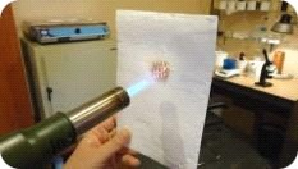 |
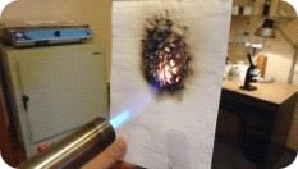 |
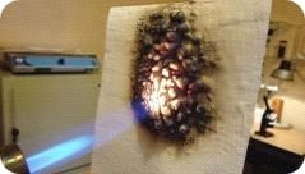 |
| One minute of exposure | Five minutes of exposure | Twenty minutes of exposure |
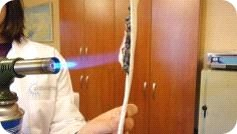
The process of RUSSIAN NANO MATERIAL coating heat treatment was accompanied by thermal mapping of both sides of cardboard sheet.Indicators of surface temperatures have been identified below (the one under exposure and the flip side).
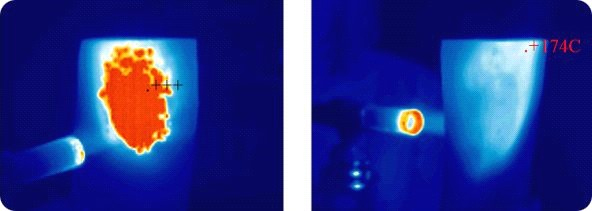
The temperature of the surface under heat exposure is outside of the thermal imager ’ s range of measurements, i.e.higher than +500 C. The temperature of a reverse side of cardboard sheet at its highest point is +174C. This temperature is lower than the combustion temperature of wood and paper, and it is below the temperature of metal melting and concrete deterioration. However, the cardboard sheet that was coated with RUSSIAN NANO MATERIAL did not catch on fire or char despite prolonged exposure to flame.

The experiment clearly shows how highly efficient fire- retardant coating RUSSIAN NANO MATERIAL is against flames and high temperatures. When exposed to high temperatures or fire RUSSIAN NANO MATERIAL bulges up to form refractory foam which prevents further heating of the structure it was applied to. Consequently a surface covered with RUSSIAN NANO MATERIAL is protected against heat and open fire treatment.
TECHNICAL SPECIFICATIONS
|
Coating appearance |
Brushed even surface |
|
Coating color |
White (pastel colors tinting is possible) |
|
Solids, minimum (% by weight) |
72 |
|
Density (kg /cubic meter) |
1200…1300 |
|
Particle size (microns) |
Not exceeding 60 |
|
Durability indoors |
Up to 30 years |
|
Durability outdoors |
Up to 20 years |
FIRE RESISTANCE RATING
|
Fire rating |
Mass factor |
RUSSIAN NANO MATERIAL dry layer thickness (mm) |
RUSSIAN NANO MATERIAL flow rate (kg /m2) |
|
45 |
3,4 |
0,7 |
1,25 |
|
60 |
3,4 |
1,35 |
2,25 |
|
90 |
5,8 |
1,65 |
2,7 |
If an object coated with RUSSIAN NANO MATERIAL is to be used outdoors its surface after drying should be painted with weatherproof paint or enamel. Thermal protective coating RUSSIAN NANO MATERIAL is suitable for these purposes as it would protect both RUSSIAN NANO MATERIAL and the structure itself from adverse atmospheric conditions (changes in temperature, light intensity, humidity, etc, and would eliminate existing "thermal bridges". If the structure doesn't have any thermal bridges then R-COMPOSIT, a water proofer coating with excellent weather resistance, flexibility and hydrophobic properties, could be used as a protective paint coating.




